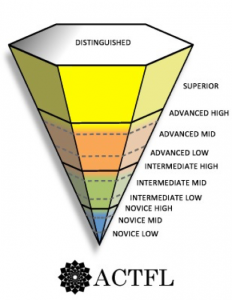Introduction
Proficiency-Based Dictionary of Yorùbá Language
Dictionaries of world languages typically provide organized lexicons of a language along with their pronunciations and meanings. Sample sentences and grammatical constructions that explicate the use of some words are also included to provide context for usage and grammatical knowledge of the language. From a functional perspective, the structure and content of dictionaries of diverse languages have over time served the language needs of everyday language users, but without much attention to foreign learners of a language, especially less commonly taught languages. This project fills this existing gap in language learning by creating organized lexicons of Yorùbá along with their meanings, sample sentences, pronunciations, some colloquial usage, and grammar explanations. Also, the vocabulary words are structured based on the American Council on the Teaching of Foreign Languages (ACTFL, 2012, 2024) proficiency guidelines and furnished with audio pronunciation of each vocabulary and audiovisual recordings of presentational and interactional communication in Yorùbá.
While the ACTFL proficiency guidelines draw on can-do statements that target learners’ competency in the language, they also integrate learning evidence, namely: function and tasks; accuracy; context and content; and text type (FACT). Within this paradigm, a learner’s proficiency is assessed in relation to the functions they can use the language. To function in a language implies the ability to produce specific communicative content accurately in light of the grammar of the language, either in written or oral form (ACTFL 2024, 5). This perspective on the assessment of language learning drives the development and organization of the pedagogy-based dictionary of Yoruba. Myriam Met & Michael Byram’s (1999, 63) distinction between content and performance standards as what learners should be able to know versus how well a learner is expected to master a particular proficiency provides additional insight into the Proficiency-Based Dictionary of Yoruba Language. By contextualizing vocabulary and grammar contents that are appropriate for learners’ proficiency levels, this project builds on the ACTFL proficiency assessment guidelines to distinctively characterize it as important reference material for Yorùbá language learners.

The African language of focus in this grand project is Yoruba, and the dictionary targets beginner learners who may have begun their learning at the Novice level but will advance their proficiency in the language to reach the intermediate level. The template of this project will be used to develop similar projects in Swahili, Wolof, Zulu, and Akan Twi. Each of these languages will be developed as separate books but interlinked as a series.
Starting with Yoruba, the project utilizes the ACTFL’s proficiency-level-based can-do statements to develop chapters for the dictionary. Each chapter organizes words alphabetically and includes meanings, pronunciation of sample sentences, and embedded audiovisuals demonstrating functional use of the language in the target culture.
Each lexical item is furnished with an audio component that learners can click on to hear isolated vocabulary so they can acquire skills for correct pronunciation of Yorùbá words. While each of the listed words has English translations, users of the dictionary also have the option to click on the translations of the monologues and dialogues of the audiovisuals across the chapters. The dictionary also offers H5P and communicative activities for practice. The grammar notes at the end of each chapter provide additional guidance on the structure of Yorùbá language.
All diacritics used in the dictionary have interpretations. The three tones of the Yoruba language mark distinction in pronunciation and meaning. All subdots on the alphabet are also included to reflect the Yoruba writing system. Each vocabulary is categorized by the part of speech, the meaning, and sample sentences. Because this dictionary provides in-depth insights into vocabulary formulation and emerging words that are being used in context, it will be reviewed and updated to reflect ongoing language practices in the target context. Such ongoing modifications and additions will provide learners with a continued understanding of the Yoruba language in use and the changes that continue to impact the vocabulary words that are being created and/or reused.
